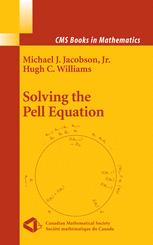

Most ebook files are in PDF format, so you can easily read them using various software such as Foxit Reader or directly on the Google Chrome browser.
Some ebook files are released by publishers in other formats such as .awz, .mobi, .epub, .fb2, etc. You may need to install specific software to read these formats on mobile/PC, such as Calibre.
Please read the tutorial at this link: https://ebookbell.com/faq
We offer FREE conversion to the popular formats you request; however, this may take some time. Therefore, right after payment, please email us, and we will try to provide the service as quickly as possible.
For some exceptional file formats or broken links (if any), please refrain from opening any disputes. Instead, email us first, and we will try to assist within a maximum of 6 hours.
EbookBell Team

0.0
0 reviewsPell's equation is a very simple, yet fundamental Diophantine equation which is believed to have been known to mathematicians for over 2000 years. Because of its popularity, the Pell equation is often discussed in textbooks and recreational books concerning elementary number theory, but usually not in much depth. This book provides a modern and deeper approach to the problem of solving the Pell equation. The main component of this will be computational techniques, but in the process of deriving these it will be necessary to develop the corresponding theory.
One objective of this book is to provide a less intimidating introduction for senior undergraduates and others with the same level of preparedness to the delights of algebraic number theory through the medium of a mathematical object that has fascinated people since the time of Archimedes. To achieve this, this work is made accessible to anyone with some knowledge of elementary number theory and abstract algebra. Many references and notes are provided for those who wish to follow up on various topics, and the authors also describe some rather surprising applications to cryptography.
The intended audience is number theorists, both professional and amateur, and students, but we wish to emphasize that this is not intended to be a textbook; its focus is much too narrow for that. It could, however be used as supplementary reading for students enrolled in a second course in number theory.